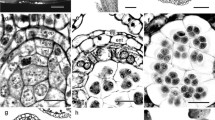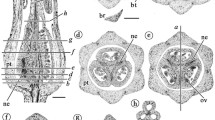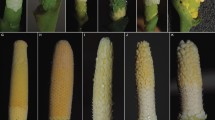Abstract
The evolution of the androecium in theOrchidaceae shows three major trends. There is a progressive trend in the degree of fusion of the filament(s) and staminode(s) to the gynoecium. Secondly, there is a reduction in the number of fertile anthers. Finally, there is a progressive change in the position of the base of the anther relative to the apex of the stigma; in the more primitive orchids the apex of the stigma is always higher than the base of the anther (this position is reversed in the higher orchids). All three trends reflect variation in the evolution of pollen dispersal and pollen reception mechanisms in theOrchidaceae. Trends in the evolution of the orchid anther(s) tend to parallel trends in the evolution of their pollinaria.
Similar content being viewed by others
Literature Cited
Ackerman, J. D., 1983: Euglossine bee pollination of the orchidCochleanthes lipscombiae: a food source mimic. — Amer. J. Bot.70, 872–876.
Adams, R. M., Goss, G. J., 1976: The reproductive biology of the epiphytic orchids of Florida, 3.Epidendrum anceps Jacquin. — Amer. Orchid Soc. Bull.45, 488–492.
Almeda, F. Jr., 1978: Systematics of the genusMonochaetum (Melastomataceae) in Mexico and Central America. — Univ. of California Press, Publications in Botany75, 1–134.
Atwood, J. T., 1982: How isPaphiopedilum pollinated? — Amer. Orchid Soc. Bull.51, 1057–1058.
Beardsell, D. V., Bernhardt, P., 1983: Pollination biology of Australian terrestrial orchids. — InWilliams, E. G., Knox, R. B., Gilbert, J. H., Bernhardt, P., (Eds.): Pollination 1982. — Parkville, Vic.: University of Melbourne Press.
Buchmann, S. L., 1983: Buzz pollination in angiosperms, pp. 73–113. — InJones, C. E., Little, R. J., (Eds.): Handbook of Experimental Pollination Biology. — New York: Van Nostrand Reinhold, Scientific and Academic Editions.
Burns-Balogh, P., Funk, V. A., 1985 (in print): A Phylogenetic Analysis of theOrchidaceae. — Smithsonian Contributions to Botany. Washington, D.C.
Calder, D. M., Adams, P. B., Slater, A. T., 1983: The floral biology and breeding system ofDendrobium speciosum Sm., pp. 184–192. — InWilliams, E. G., Knox, R. B., Gilbert, J. H., Bernhardt, P.: Pollination 1982. — Univ. of Melbourne, Parkville, Victoria, Australia.
Catling, P. M., 1983: Pollination of North AmericanSpiranthes (Orchidaceae). — Can. J. Bot.61, 1080–1093.
Coleman, E., 1929: Pollination of an Australian orchid:Cryptostylis leptochila Muell. F. V. — Ann. Bot.67, 97–99.
Dafni, A., Ivri, Y., 1981: Floral mimicry betweenOrchis israelitica Baumann & Dafni (Orchidaceae) andBellevalia flexuosa Boiss. (Liliaceae). — Oecologia (Berl.)49, 229–232.
Dahlgren, R. M., Clifford, H. T., 1982: The Monocotyledons: A Comparative Study. — London: Academic Press.
Dressler, R. L., 1981: The Orchids, Natural History and Classification. — Cambridge, Massachusetts.
Dulberger, R., Ornduff, R., 1980: Floral morphology and reproductive biology of four species ofCyanella (Tecophileaceae). — New Phyt.86, 45–56.
Erickson, R. E., 1958: Triggerplants. — Paterson Brokensha Pty. Ltd.
Faegri, K., van der Pijl, L., 1966: Principles of Pollination Ecology. — London: Pergamon Press.
Free, J. B., 1970: Insect Pollination of Crops. — London: Academic Press.
Godley, E., 1979: Flower biology in New Zealand. — New Zealand J. Botany17, 441–466.
Goss, G. J., 1977a: The reproductive biology of the epiphytic orchids of Florida, 5.Epidendrum difforme Jacquin. — Amer. Orchid Soc. Bull.46, 630–636.
, 1977b: The reproductive biology of the epiphytic orchids of Florida, 6.Polystachya flavescens (Lindley)Smith, J. J. — Amer. Orchid Soc. Bull.46, 990–994.
Heywood, V. H., (Ed.), 1978: Flowering Plants of the World. — New York: Mayflower books.
Hopper, S. D., Burbidge, A. H., 1978: Assortive pollination by Red Wattlebirds (Anthochaera carunculata Shawn,Meliphagidae) in a hybrid population ofAnigozanthus Labill. (Haemodoraceae). — Aust. J. Bot.26, 335–350.
Janzen, D. H., DeVries, P., Gladstone, D. E., Higgins, M. L., 1980: Self- and cross-pollination ofEncyclia cordigera (Orchidaceae) in Santa Rosa National Park, Costa Rica. — Biotropica12, 72–74.
Johns, J., Molloy, B., 1983: Native Orchids of New Zealand. — Wellington, New Zealand: A. H. and A. W. Reed Ltd.
Jones, D. L., 1972: The pollination ofPrasophyllum alpinum R. Br. — Vict. Nat.89, 260–263.
, 1975: The pollination ofMicrotis parviflora R. Br. — Annals of Bot.39, 585–589.
- 1981: The pollination of selected Australian orchids, pp. 40–43. — In Proceedings Orchid Symp. 13th Intl. Bot. Congr., Sydney, Australia.
, 1974: The pollination ofCalochilus holtzei F. Muell. — Amer. Orchid Soc. Bull.43, 604–606.
, 1977: The pollination ofDendrobium ruppianum Hawkes, A. D. — Amer. Orchid Soc. Bull.46, 54–57.
Kennedy, H., 1978: Systematics and pollination of the “closed-flowered” species ofCalathea (Marantaceae). — Univ. of California Press, Publications in Botany71, 1–90.
Luer, C. A., 1975: The native orchids of the United States and Canada, excluding Florida. — New York: New York Botanical Garden.
Mehrhoff, L. A., 1983: Pollination in the genusIsotria (Orchidaceae). — Amer. J. Bot.70, 1444–1453.
Nicholls, W. H., 1969: Orchids of Australia. — Melbourne: Thomas Nelson Ltd.
Nilsson, L. A., 1978a: Pollination ecology and adaptation inPlatanthera chlorantha (Orchidaceae). — Bot. Notiser131, 35–51.
, 1978b: Pollination ecology ofEpipactis palustris (Orchidaceae). — Bot. Notiser131, 355–368.
, 1979a: Anthecological studies on the lady's slipper,Cypripedium calceolus (Orchidaceae). — Bot. Notiser132, 329–347.
, 1979b: The pollination ecology ofHerminium monorchis (Orchidaceae). — Bot. Notiser132, 537–542.
, 1980: The pollination ecology ofDactylorhiza sambucina (Orchidaceae). — Bot. Notiser133, 367–385.
, 1981: The pollination ecology ofListera ovata (Orchidaceae). — Nord. J. Bot.1, 461–480.
, 1983: Anthecology ofOrchis mascula (Orchidaceae). — Nord. J. Bot.3, 157–179.
Richard, L. C., 1817 (preprint): De Orchideis Europaeis Annotationes, Praesertim ad Genera Dilucidanda Spectantes. — Paris.
Schweinfurth, C., 1959: Classification of orchids. — InWithner, C.: The Orchids, a Scientific Survey. — New York: The Ronald Press Co.
Senghas, K., 1973:Orchidoideae. — InBrieger, F. G., Maatsch, R., Senghas, K., (Eds.):R. Schlechter's Die Orchideen. — Berlin: Verlag Paul Parey.
Stebbins, G. L., 1967: Adaptive radiation and trends of evolution in higher plants. — InDobzhansky, T., Hecht, M. K., Steere, W. C., (Eds.): Evolutionary Biology1: pp. 101–140. — Amsterdam: North Holland Publishing Co.
Stoutamire, W. P., 1967: Flower biology of the lady's slipper (Orchidaceae: Cypripedium). — Mich. Bot.6, 159–175.
Thien, L. B., 1969: Mosquito pollination ofHabenaria obtusata (Orchidaceae). — Amer. J. Bot.56, 232–237.
, 1972: The floral biology ofArethusa bulbosa, Calopogon tuberosus andPogonia ophioglossoides (Orchidaceae). — Can. J. Bot.50, 2319–2325.
Van der Pijl, L., Dodson, C. H., 1966: Orchid Flowers, Their Pollination and Evolution. — Coral Gables: University of Miami Press.
Vogel, S., 1978: Evolutionary shifts from reward to deception in pollen flowers, pp. 89–96. — InRichards, A. J., (Ed.): The Pollination of Flowers by Insects. — Linn. Soc. Symp. No.6. — London: Academic Press.
Williams, N. H., 1982: The biology of orchids and euglossine bees, pp. 121–171. — InArditti, J.: Orchid Biology, Reviews and Perspectives, II. — Ithaca: Cornell Univ. Press.
Author information
Authors and Affiliations
Rights and permissions
About this article
Cite this article
Burns-Balogh, P., Bernhardt, P. Evolutionary trends in the androecium of theOrchidaceae . Pl Syst Evol 149, 119–134 (1985). https://doi.org/10.1007/BF00984157
Received:
Issue Date:
DOI: https://doi.org/10.1007/BF00984157




